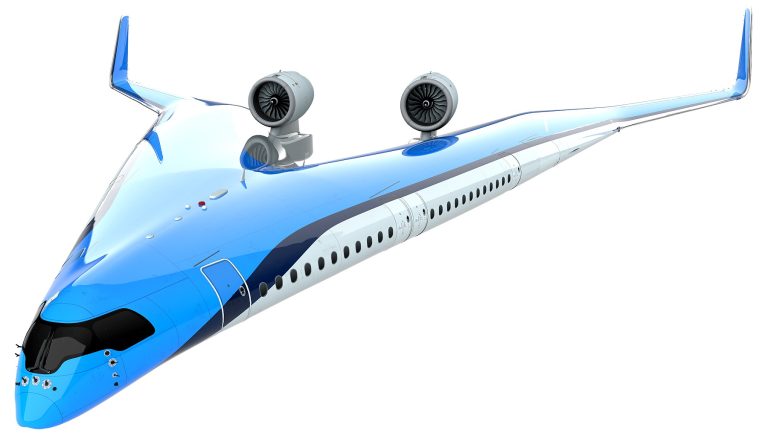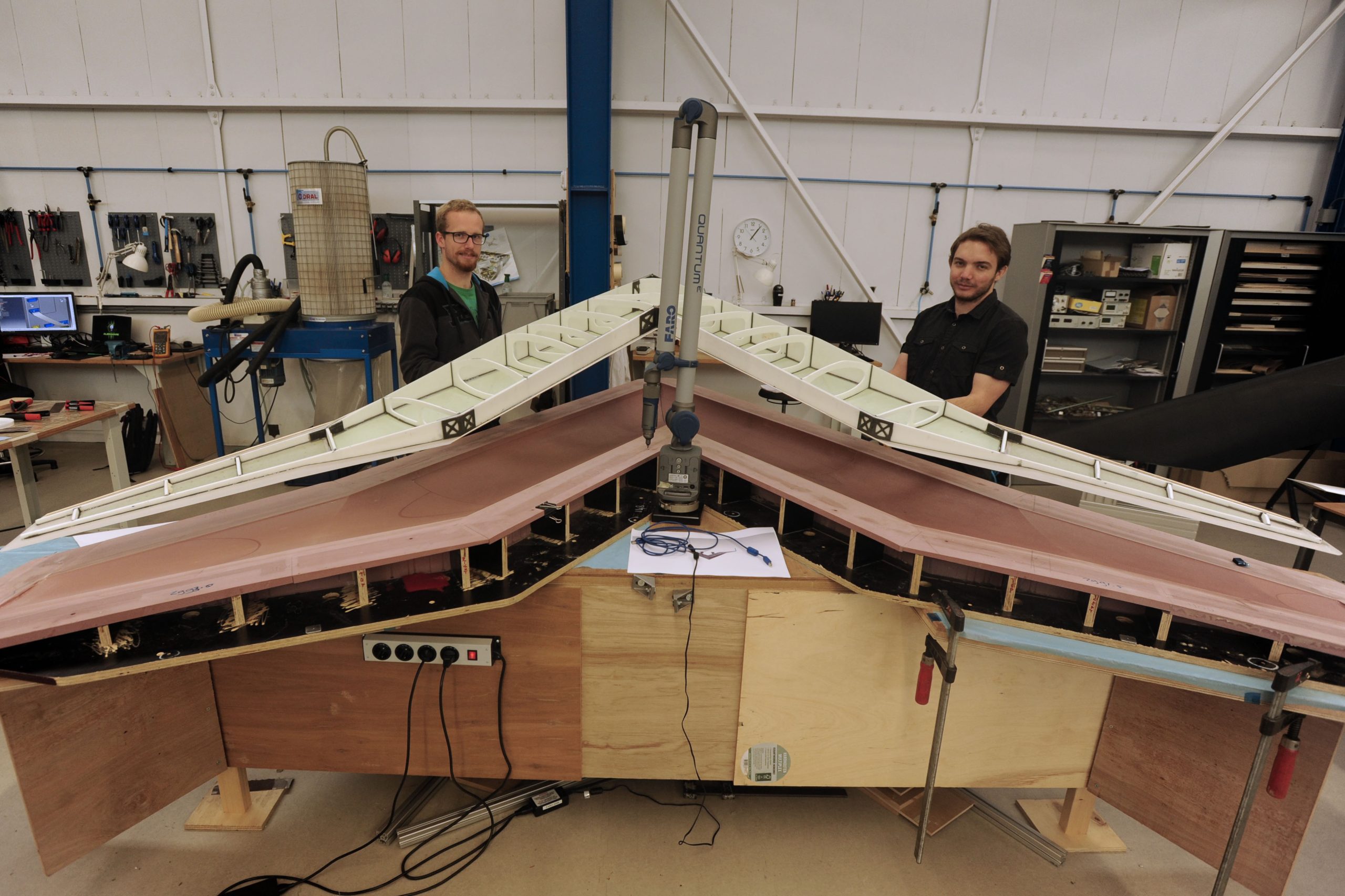Much work is being done at Aerospace Engineering on a new type of aircraft. The Flying-V tailless aircraft integrates the cabin, hold and fuel tanks in the wing.
Malcom Brown (left): “It’s a real challenge making this aircraft light enough to be able to fly in September.” (Photo: Tomas van Dijk)
“You should try to lift this aircraft engine.” Researcher Malcom Brown carefully takes one of the most important parts of the aircraft out of a cupboard. Even the undercarriage is sturdy and heavy. “It’s a real challenge making this aircraft light enough to be able to fly in September.”
Brown is one of the researchers at the Faculty of Aerospace Engineering that is working with students on a scale model of the Flying-V. The contours of this V shaped aircraft are already visible in a big mould in the Faculty’s hangar. Using a robot arm that knows the precise position of all the parts of the aircraft, Brown is assembling the craft piece by piece.
But there is some need for haste. The 2.5 metre long aircraft with its three metre wingspan (1:20 scale) will be presented during the KLM Experience Days at Schiphol. This event is being organised to mark KLM’s 100th anniversary. The radiographic aircraft must fly before the event starts. Images of the aircraft and part of its interior at scale will also be displayed at Schiphol.
A couple of weeks ago, TU Delft and KLM announced that the airline company is investing in this TU Delft project. Project Manager Dr Roelof Vos (Faculty of Aerospace Engineering) does not want to divulge the amount that KLM is putting into the research. “It is financial support. To date, the only people who were working on this research were the students, and the study was barely put down on paper. Now we have the means to pay technicians and to make a scale model.”
 KLM’s vision on the future.
KLM’s vision on the future.Work has been ongoing since the 1950s to give jet aircraft that characteristic cigar shaped fuselage. Since these aircraft have taken over the sky, they have become more energy efficient and quieter. But the max has been reached. Aircraft manufacturers need to turn to another radical design if their aircraft are to be more efficient.
Aircraft whose fuselage and wings merge in a ‘blended wing body’ are far more aerodynamic. The military forces happily use this shape. But it is just not taking off in the commercial airline industry.
The TU Delft researchers hope to change this. The cabin, hold and fuel talks are integrated in the Flying-V. The entire aircraft is, in fact, one giant V shaped wing.
‘Our aircraft can be extended or shortened easily’
Vos explains that this design deviates from the decades old blended wing concept in one point. “Our aircraft can be extended or shortened easily as the wings have consistent diameters. Similar to conventional passenger aircraft, you can add sections to make groups of aircraft of various sizes. This will make a new type of aircraft like this viable. This is not easy to do with blended wing aircraft as each section of the aircraft is different.”
The design is not 100% TU Delft. The engineers are building on an Airbus patent. In 2014, a third year student at the TU Berlin, who was doing an internship at Airbus, hit on a good idea. He stuck two A320 fuselages together in a V shape on his drafting table to give the construction a more streamlined wing shape. He also added two extra small wings at the tips. Airbus saw the potential of the design and patented it.
Vos was intrigued. “I saw the design and thought ‘that’s great’. But is it really so promising? We have embarked on an independent assessment adopting a healthy critical academic stance. We started doing calculations and modified the shape somewhat, making the wings more oval.”
As the shape of this aircraft is more aerodynamic and the aircraft is lighter, it could use 20% less fuel than the Airbus A320. But the Airbus A320 serves as a reference point. The Flying-V should be able to carry about the same number of passengers (314) and the same volume of cargo (160 m3).
It will still be a long time before an aircraft like this will carry passengers. If, that is, the whole thing goes ahead. “In any case, it won’t be before 2040,” says Vos. The press release that TU Delft issued upon signing the collaboration agreement with KLM is also modest. It says that ‘the aircraft is being designed as a possible aircraft design for the future.’
Brown sees the stability of the aircraft as another major challenge. “This is still a point of consideration. In conventional aircraft, the rudder is right at the back, on the tail. This aircraft needs to be steered with the wings. That’s a lot more difficult.”
Sitting in a rollercoaster
On the technology website arstechnica.com, responses to the Flying-V are critical. Passengers will feel like they are sitting in a rollercoaster, claims the site. As passengers will be placed relatively far from the aircraft’s centre line, they will feel higher G forces when the aircraft turns. This will certainly be the case for economy class passengers as they will be further behind in and towards the sides of the aircraft.
Vos thinks that it won’t be that bad. “Airbus tested this by putting people in a simulator. They had no trouble at all within 11 or 12 metres of the centre line. We are retaining this distance in our design.”
In Airbus’ original drawing, the passenger seats were placed quite a bit towards the back, towards the wing tips. In TU Delft’s design, the luggage is placed in the back half of the aircraft.
Another important question is how fast passengers can evacuate the aircraft in an emergency. All passengers need to evacuate an aircraft within 90 seconds using only half the emergency exits. “We still need to try this out,” says Vos. “We don’t need the real aircraft to test this. We can run experiments with test persons in a space with the same dimensions. We may need to adapt the aircraft in line with evacuation requirements, but I don’t expect this to stop the show.”
Do you have a question or comment about this article?
tomas.vandijk@tudelft.nl


Comments are closed.